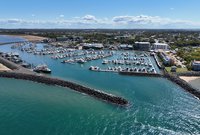Affordable and Liveable Property Guides 1st Half 2024
The PRD Affordable and Liveable Property Guides 1st Half 2024 are available for Brisbane, Sydney, Melbourne, and Hobart. These guides provide valuable insights into property trends and how current economic conditions (including higher interest rates) have impacted the market, as well as future developments for 2024. For those looking for more affordable options (compared to the capital city metro area), these guides provide key suburbs that have passed the affordability, investment, liveability, and future residential stock supply criteria.

As featured on:

Download all the Affordable and Liveable Property Guides below:
PRD Affordable and Liveable Property Guide 1st Half 2024 - Brisbane
PRD Affordable and Liveable Property Guide 1st Half 2024 - Sydney
PRD Affordable and Liveable Property Guide 1st Half 2024 - Melbourne
PRD Affordable and Liveable Property Guide 1st Half 2024 - Hobart
Key Findings
- The move to purchasing units is inevitable. The percentage of affordable suburbs (i.e. suburbs with a lower median house/unit price than the relevant Metro area) for units is much higher, at an average of 39.0% across Sydney, Brisbane, Melbourne and Hobart. This is almost double the 20.5% average for the percentage of affordable suburbs for houses.
- Brisbane proves to be the most welcoming capital city for first-home buyers, with 27.6% affordable suburbs for houses, and 43.1% for units. Although this is lower than in previous years, making Brisbane more expensive for locals, it is the highest percentage compared to other capital cities. Sydney is the least friendly for houses, with only 11.1% of affordable suburbs, and Hobart is the least friendly for units, with 34.0% of affordable suburbs. Further, new residential supply indicates most of the stock planned are units as opposed to townhouses and houses.
- As per the 1st and 2nd Half 2023 Affordable and Liveable Property Guide reports, we had to sacrifice the unemployment rate in favour of high project development value, with the assumption that a high level of commercial and infrastructure projects would stimulate local employment in the future.
- Choosing affordable and liveable suburbs in Brisbane and Hobart proved to be more difficult, especially with the new methodology requirement. For the 1st half of 2024, we now consider the level of residential stock planned due to the housing supply crisis. Sydney and Melbourne proved easier, as there were more affordable suburbs with residential stock in the pipeline.
- Many suburbs in Melbourne and Sydney are still experiencing negative growth, as they are still commencing their market recovery periods. Now is the ideal time for first-home buyers.
Percentage of Affordable Suburbs
Table 1 illustrates the percentage of affordable suburbs in each capital city, where an ‘affordable suburb’ is defined as a suburb that has a lower median house/unit price compared to the relevant Metro area. This table suggests that there is hope for unit buyers.
Table 1. Percentage of Affordable Suburbs – 1st Half 2024
Affordable & Liveable Suburbs
Table 2 identifies affordable and liveable suburbs that have met all methodology criteria. Hobart has the most affordable chosen suburbs for houses, followed by Melbourne. For the first time, Brisbane’s chosen suburbs have a higher median house price than Melbourne. Chosen suburbs for units show median prices that are roughly on par between all four capital cities, which is also a first. This further confirms the move to favouring units and indicates where the opportunities are for first-home buyers.
Methodology
Each Affordable and Liveable Property Guide focuses on suburbs within a 20km radius of the CBD (or 10km for Hobart), taking into consideration the following criteria:
- Property trends criteria – all suburbs have a minimum of 20 sales transactions for statistical reliability purposes. Based on market conditions, suburbs have either positive or as close as possible to neutral price growth between 2022 to 2023/24*.
- Investment criteria – as of March 2024, suburbs considered will have an on-par or higher rental yield than the relevant Metro, and an on-par or lower vacancy rate.
- Affordability criteria – identified affordable and liveable suburbs have a median price below the relevant capital city metro area, and below a set threshold. This threshold was set by adding a percentage premium to the respective State’s average home loan***. The percentage premium needed to achieve the affordable and liveable suburb’s median house/unit price must be lower than the percentage premium needed to achieve the City Metro area’s median house/unit price. This ensures higher affordability.
- Development criteria – suburbs identified must have a high total estimated value of future project development for 2024, with a high proportion of commercial and infrastructure projects. This ensures the suburbs show signs of sustainable economic growth. Suburbs must also show a reasonable amount of new ready-to-sell stock planned for construction, to ensure there is stock available for buyers.
- Liveability criteria – all identified suburbs have low crime rates, availability of amenities within a 5km radius (i.e. schools, green spaces, public transport, shopping centres and health care facilities), and an unemployment rate on-par or lower in comparison to the QLD average (as determined by the Department of Jobs and Small Business, December Quarter 2023 release).
*Median price quoted captures sale transactions from 1st January 2023 to 31st March 2024, or Q1 2023 – Q1 2024. **New Supply is based on an aggregate number of ready-to-sell townhouses, units and dwellings scheduled to commence construction in 2024, as stated by the relevant data authority.
***Average home loan figure is derived from the December Quarter 2023 Housing Affordability Report by the Real Estate Institute of Australia (REIA) and Adelaide Bank.







